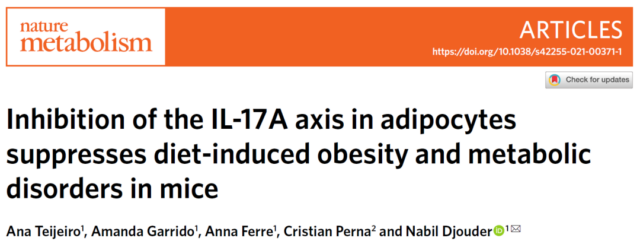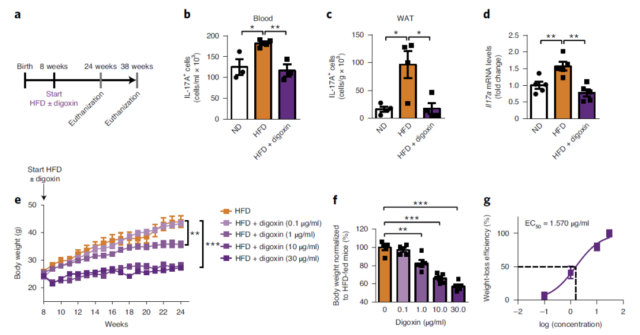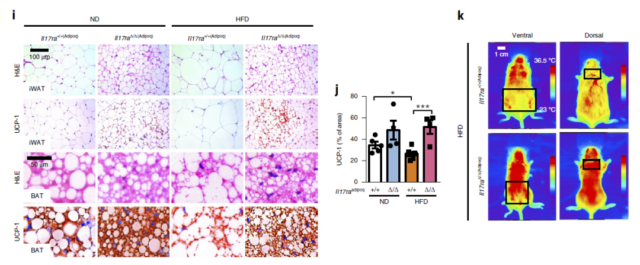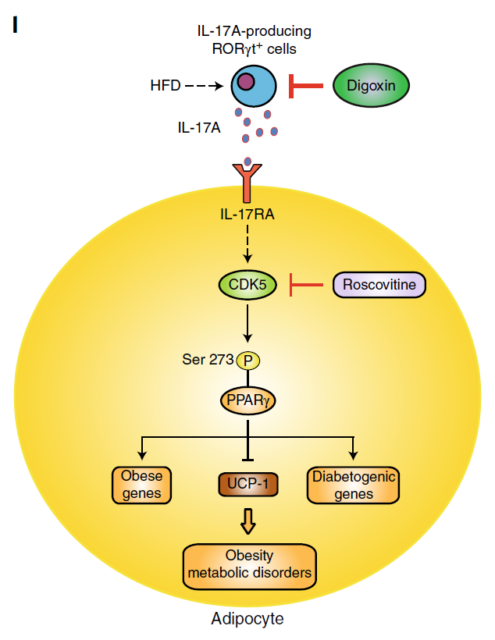Nature: Lose weight without restraining your diet by Inhibiting this cytokine
- Normal Liver Cells Found to Promote Cancer Metastasis to the Liver
- Nearly 80% Complete Remission: Breakthrough in ADC Anti-Tumor Treatment
- Vaccination Against Common Diseases May Prevent Dementia!
- New Alzheimer’s Disease (AD) Diagnosis and Staging Criteria
- Breakthrough in Alzheimer’s Disease: New Nasal Spray Halts Cognitive Decline by Targeting Toxic Protein
- Can the Tap Water at the Paris Olympics be Drunk Directly?
Nature: Lose weight without restraining your diet by Inhibiting this cytokine. With the improvement of living standards, the incidence of obesity and overweight continues to soar in countries around the world, and has evolved into a global health problem.
More importantly, there is currently no effective treatment for obesity caused by overnutrition.
It is worth noting that obesity is closely related to the body’s metabolism and immune function. One of the key features is that obesity can cause low-level inflammation, which makes the body prone to metabolic syndrome. However, the specific mechanism behind this phenomenon has not been studied in depth.
On April 15, 2021, researchers from the Spanish National Cancer Research Center published in the journal Nature Metabolism the title:
Inhibition of the IL-17A axis in adipocytes suppresses diet-induced obesity and metabolic disorders in mice
Research papers.
This study shows that inhibiting the interleukin-17A (IL-17A) signal axis can inhibit diet-induced obesity and metabolic disorders, and promote fat tissue “browning”, thermogenesis, and energy expenditure.
These findings reveal the unexpected role of the immune factor IL-17A in adipocyte biology, and suggest that targeting the IL-17A axis may be an effective anti-obesity strategy.

Long-term excessive eating and insufficient physical activity can cause excessive fat accumulation and lead to obesity and overweight. Research data shows that 1.9 billion adults worldwide are overweight and 600 million people are obese, and it is estimated that 51% of the global population will be obese by 2030. Therefore, obesity is a major global health problem and its incidence is increasingly worrying.
More importantly, obesity will further cause metabolic syndrome and accompany various complications, such as type 2 diabetes, hypertension, non-alcoholic steatohepatitis, cardiovascular disease, and cancer. It can be seen that the development of a treatment strategy for obesity is very important for human health.
Previous studies have shown that nutrients themselves are inflammatory and increase the level of interleukin-17A (IL-17A). This suggests that there may be potential links between overnutrition, IL-17A signal axis, obesity, and metabolic diseases.
Based on this, in this study, the research team used digoxin or knocked out IL-17A receptor (IL-17RA) to inhibit IL-17A in a mouse model. Researchers found that these treatments can promote the “browning” of white adipose tissue in mice, increase the body’s heat production and energy expenditure, and thereby inhibit diet-induced obesity and metabolic disorders in mice.

Digoxin prevents diet-induced obesity and metabolic disorders
Adipose tissue can be divided into two categories according to its anatomical location and function-white adipose tissue (WAT) and brown adipose tissue (BAT). Simply put, WAT is responsible for storing fat, and BAT is responsible for heat production, but the boundary between the two is not absolute. WAT has extraordinary physiological plasticity and can obtain part of the characteristics of BAT, that is, the “browning” of white adipose tissue.
The researchers said that the IL-17A signaling pathway axis is very important for diet-induced obesity and metabolic disorders, whether it is inhibiting IL-17A production or specifically knocking out IL-17A receptors in adipocytes; whether it is high altitude Xin, which is also a RORγt inhibitor (activation of RORγt can promote IL-17A production), can prevent diet-induced obesity and metabolic dysfunction in mice.

Knocking out the IL-17A receptor gene specifically in adipocytes can prevent diet-induced obesity and metabolic dysfunction
Not only that, the research team also revealed that the IL-17A axis is a signaling pathway that mediates obesity independent of the leptin axis. IL-17A produced by diet-induced obesity induces the phosphorylation of PPARγ Ser273 in adipocytes in a CDK5-dependent manner, thereby changing the expression of diabetes and obesity genes.
In addition, in order to evaluate the clinical relevance of the study, the research team analyzed the visceral WAT of 75 morbidly obese patients and revealed that the IL-17A signaling pathway is related to the obesity gene of human WAT.

IL-17A phosphorylates PPARγ in adipocytes to promote obesity
Overall, this study provides strong evidence that IL-17A plays a crucial role in diet-induced obesity and metabolic disorders: in adipocytes, IL-17A induces PPARγ Ser273 in adipocytes Phosphorylation not only inhibits WAT browning and BAT activity, but also inhibits genes related to the protection of obesity and insulin resistance.
Based on this discovery, we can develop weight-loss drugs targeting the IL-17A signal axis in the future, so that the majority of “weight-loss people” can effectively prevent and cure obesity without restraining their appetite!
(source:internet, reference only)
Disclaimer of medicaltrend.org



